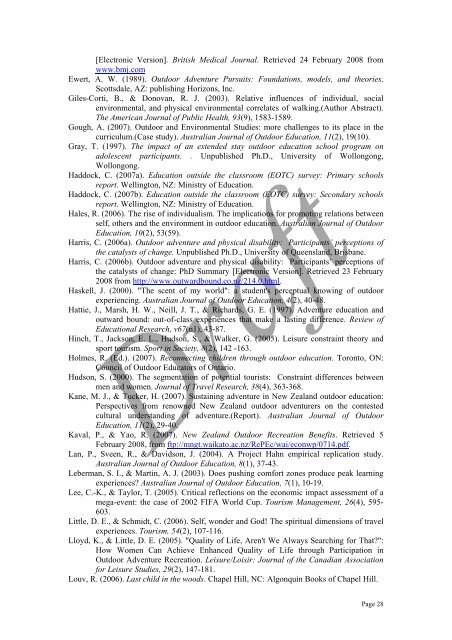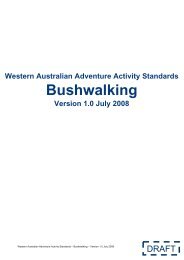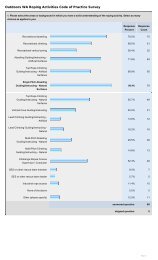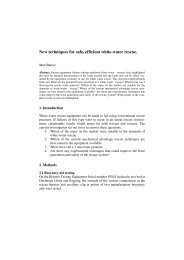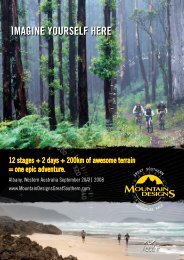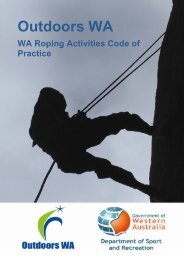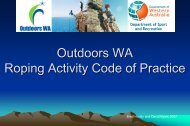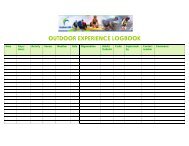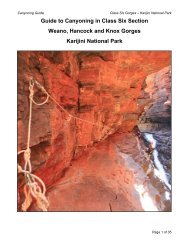Outdoor Adventure Activities Benefits Catalogue - Outdoors WA
Outdoor Adventure Activities Benefits Catalogue - Outdoors WA
Outdoor Adventure Activities Benefits Catalogue - Outdoors WA
Create successful ePaper yourself
Turn your PDF publications into a flip-book with our unique Google optimized e-Paper software.
[Electronic Version]. British Medical Journal. Retrieved 24 February 2008 fromwww.bmj.comEwert, A. W. (1989). <strong>Outdoor</strong> <strong>Adventure</strong> Pursuits: Foundations, models, and theories.Scottsdale, AZ: publishing Horizons, Inc.Giles-Corti, B., & Donovan, R. J. (2003). Relative influences of individual, socialenvironmental, and physical environmental correlates of walking.(Author Abstract).The American Journal of Public Health, 93(9), 1583-1589.Gough, A. (2007). <strong>Outdoor</strong> and Environmental Studies: more challenges to its place in thecurriculum.(Case study). Australian Journal of <strong>Outdoor</strong> Education, 11(2), 19(10).Gray, T. (1997). The impact of an extended stay outdoor education school program onadolescent participants. . Unpublished Ph.D., University of Wollongong,Wollongong.Haddock, C. (2007a). Education outside the classroom (EOTC) survey: Primary schoolsreport. Wellington, NZ: Ministry of Education.Haddock, C. (2007b). Education outside the classroom (EOTC) survey: Secondary schoolsreport. Wellington, NZ: Ministry of Education.Hales, R. (2006). The rise of individualism. The implications for promoting relations betweenself, others and the environment in outdoor education. Australian Journal of <strong>Outdoor</strong>Education, 10(2), 53(59).Harris, C. (2006a). <strong>Outdoor</strong> adventure and physical disability: Participants’ perceptions ofthe catalysts of change. Unpublished Ph.D., University of Queensland, Brisbane.Harris, C. (2006b). <strong>Outdoor</strong> adventure and physical disability: Participants’ perceptions ofthe catalysts of change: PhD Summary [Electronic Version]. Retrieved 23 February2008 from http://www.outwardbound.co.nz/214.0.html.Haskell, J. (2000). "The scent of my world": a student's perceptual knowing of outdoorexperiencing. Australian Journal of <strong>Outdoor</strong> Education, 4(2), 40-48.Hattie, J., Marsh, H. W., Neill, J. T., & Richards, G. E. (1997). <strong>Adventure</strong> education andoutward bound: out-of-class experiences that make a lasting difference. Review ofEducational Research, v67(n1), 43-87.Hinch, T., Jackson, E. L., Hudson, S., & Walker, G. (2005). Leisure constraint theory andsport tourism. Sport in Society, 8(2), 142 -163.Holmes, R. (Ed.). (2007). Reconnecting children through outdoor education. Toronto, ON:Council of <strong>Outdoor</strong> Educators of Ontario.Hudson, S. (2000). The segmentation of potential tourists: Constraint differences betweenmen and women. Journal of Travel Research, 38(4), 363-368.Kane, M. J., & Tucker, H. (2007). Sustaining adventure in New Zealand outdoor education:Perspectives from renowned New Zealand outdoor adventurers on the contestedcultural understanding of adventure.(Report). Australian Journal of <strong>Outdoor</strong>Education, 11(2), 29-40.Kaval, P., & Yao, R. (2007). New Zealand <strong>Outdoor</strong> Recreation <strong>Benefits</strong>. Retrieved 5February 2008, from ftp://mngt.waikato.ac.nz/RePEc/wai/econwp/0714.pdf.Lan, P., Sveen, R., & Davidson, J. (2004). A Project Hahn empirical replication study.Australian Journal of <strong>Outdoor</strong> Education, 8(1), 37-43.Leberman, S. I., & Martin, A. J. (2003). Does pushing comfort zones produce peak learningexperiences? Australian Journal of <strong>Outdoor</strong> Education, 7(1), 10-19.Lee, C.-K., & Taylor, T. (2005). Critical reflections on the economic impact assessment of amega-event: the case of 2002 FIFA World Cup. Tourism Management, 26(4), 595-603.Little, D. E., & Schmidt, C. (2006). Self, wonder and God! The spiritual dimensions of travelexperiences. Tourism, 54(2), 107-116.Lloyd, K., & Little, D. E. (2005). "Quality of Life, Aren't We Always Searching for That?":How Women Can Achieve Enhanced Quality of Life through Participation in<strong>Outdoor</strong> <strong>Adventure</strong> Recreation. Leisure/Loisir: Journal of the Canadian Associationfor Leisure Studies, 29(2), 147-181.Louv, R. (2006). Last child in the woods. Chapel Hill, NC: Algonquin Books of Chapel Hill.Page 28


